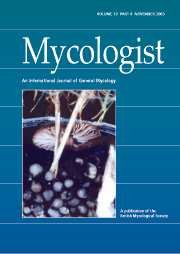Article contents
Teaching techniques for mycology: 18. Rhytisma acerinum, cause of tar-spot disease of sycamore leaves
Published online by Cambridge University Press: 17 September 2002
Abstract
Name of fungus
Teleomorph: Rhytisma acerinum (Pers.) Fr. (order Rhytismatales, family Rhytismataceae)
Anamorph: Melasmia acerina Lév.
Introduction: Features of interest
Tar-spot disease on leaves of sycamore (Acer pseudoplatanus L.) is one of the most easily recognised foliar plant diseases caused by a fungus (Figs 1 and 4). First described by Elias Fries in 1823, knowledge of it had become well-established by the latter half of the 19th century (e.g. Berkeley, 1860; Massee, 1915). The causal fungus, Rhytisma acerinum, occurs in Europe and North America on A. pseudoplatanus throughout its distribution range and also on other species of Acer (Sutton, 1980; Farr et al., 1989), but it is less frequent in urban and industrial areas.
The black tar-spots visible in late summer and autumn are stromata containing many apothecial rudiments, but these only mature to form asci during the winter on fallen leaves (Jones, 1925; Duravetz & Morgan-Jones, 1971). Maturing apothecial stromata develop linear or convoluted ridge-like swellings which raise the thick black layer (clypeus) on the upper surface of the stroma (Fig 1). Eventually, the surface breaks along the ridges (Fig 2), exposing a greyish hymenium (Fig 3) which contains club-shaped asci and filamentous paraphyses with curved or recoiled tips (Figs 8 and 9). The ascospores are unicellular and needle-shaped, with an apical mucilage pad (Fig 10). In Britain and Europe, ascospore discharge from overwintered stromata takes place in March and April, just as the new sycamore leaves unfold.
- Type
- Original Article
- Information
- Copyright
- © 2002 Cambridge University Press
- 7
- Cited by




